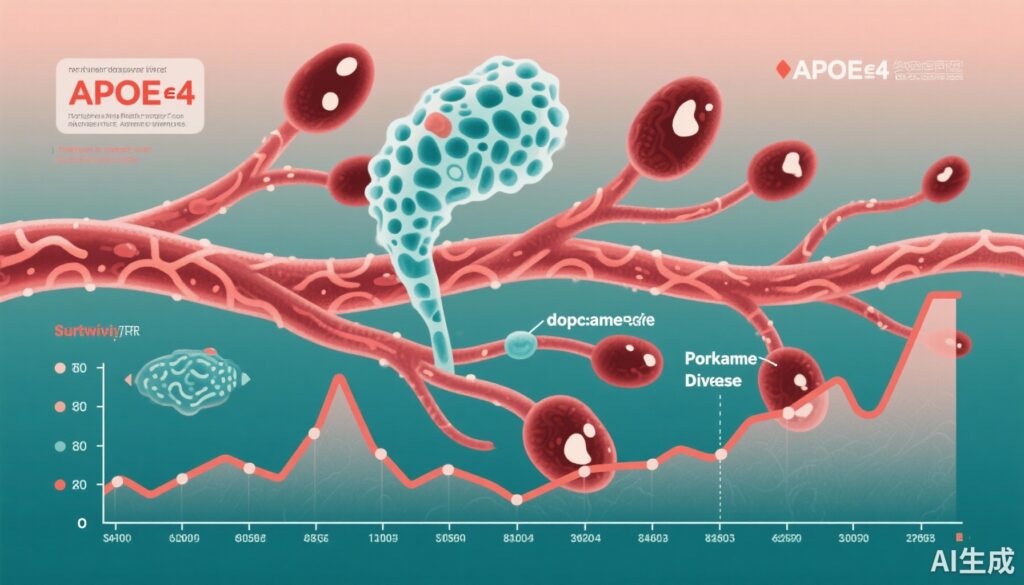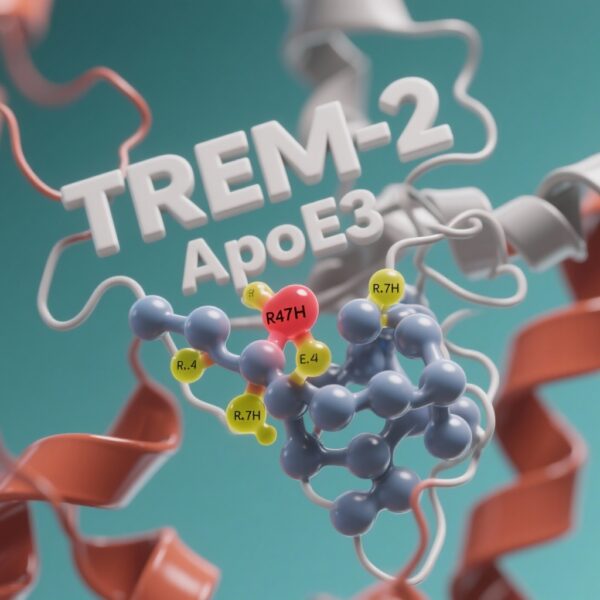Highlight
– The APOE ε4 allele (rs429358) is significantly associated with reduced survival in patients with Parkinson’s disease (PD), independent of the presence of dementia.
– Time-to-event genome-wide analysis in a large cohort of White European PD patients identified APOE ε4 as a genetic determinant negatively impacting patient survival.
– Cellular models expressing APOE ε4 under PD-related stress conditions demonstrated reduced cell viability, mitochondrial dysfunction, increased DNA damage, and activation of endoplasmic reticulum (ER) stress via the PERK pathway.
– These findings reveal biological mechanisms through which APOE ε4 may influence PD progression and patient mortality beyond cognitive decline.
Study Background
Parkinson’s disease (PD) is a progressive neurodegenerative disorder characterized by motor symptoms and a range of non-motor complications including dementia. Patients with PD generally have a decreased life expectancy compared to the general population. Variability in survival among PD patients can be significant, influenced by various clinical and genetic factors. While dementia is a known major predictor of poorer outcomes, the role of specific genetic variants in modulating PD survival has not been fully elucidated. The APOE ε4 allele, a well-known genetic risk factor for Alzheimer’s disease and cognitive impairment, has been hypothesized to contribute to PD prognosis, but whether it independently affects survival beyond dementia remains unclear.
Study Design
This investigation included a large cohort of 3,940 unrelated White European PD patients from the UK Biobank cohort, comprising 2,365 living and 1,575 deceased individuals. Of the deceased, 503 had PD registered as the primary cause of death, and 423 as the secondary cause. A genome-wide time-to-event analysis was conducted employing a Cox proportional hazards regression model with a saddle point approximation to identify genetic variants linked to survival time. The primary analyses focused on three cohorts: (I) PD as the primary cause of death; (II) PD as either primary or secondary cause of death; and (III) all-cause mortality among PD patients. Additionally, the effects of APOE ε4 were studied in vitro using SH-SY5Y neuroblastoma cells overexpressing different APOE isoforms, exposed to rotenone to mimic PD-related mitochondrial stress. Various assays including cell viability, flow cytometry, immunofluorescence, and western blotting were used to delineate cellular effects and underlying pathways.
Key Findings
Genetic Association with Survival: The rs429358 variant, defining the APOE ε4 allele, showed a strong and genome-wide significant association with reduced survival in PD patients across all three cohorts (P < 1.6 × 10-8). Multivariate Cox models demonstrated that both clinically diagnosed dementia and the APOE ε4 genotype were significant, independent predictors of shorter survival. Dementia conferred a hazard ratio (HR) > 2, indicating more than double the risk of death, while APOE ε4 carriage was associated with a modest but significant HR > 1.2.
Cellular Mechanisms Underlying APOE ε4 Effects: In the SH-SY5Y cell model, expression of the APOE ε4 isoform selectively reduced cell viability under rotenone-induced stress, which simulates mitochondrial dysfunction seen in PD. This reduction was not observed in cells expressing other APOE isoforms, suggesting allele-specific vulnerability. Concomitantly, APOE ε4 expression correlated with impaired mitochondrial function as evidenced by reduced mitochondrial membrane potential and ATP production, increased DNA damage markers, and activation of ER stress, particularly via the PERK (protein kinase RNA-like ER kinase) signaling arm. These molecular disturbances potentially exacerbate neuronal damage and contribute to neurodegeneration independent of dementia pathology.
Expert Commentary
The study robustly highlights APOE ε4 as a genetic factor that detrimentally influences survival in Parkinson’s disease, adding an important dimension to our understanding beyond its established role in dementia risk. The large, well-characterized cohort and stringent genome-wide statistical approach strengthen the validity of the findings. The integration of human genetic data with cellular mechanistic validation enhances biological plausibility.
However, some limitations are noteworthy. The study population was limited to White European ancestry, which may affect generalizability to other ethnic groups. Furthermore, while the in vitro model recapitulates key PD-related stress, it cannot fully represent the complex in vivo neuronal environment. Future studies incorporating longitudinal clinical data, biomarkers, and more diverse populations will be crucial. Potential therapeutic implications include targeting mitochondrial and ER stress pathways in APOE ε4 carriers to improve outcomes.
Conclusion
This comprehensive analysis provides compelling evidence that the APOE ε4 allele adversely affects survival in Parkinson’s disease independently from its effect on dementia. The allele’s association with mitochondrial dysfunction and ER stress may underlie enhanced neuronal vulnerability and accelerated disease progression. These insights urge consideration of APOE ε4 status in prognostic assessment and the development of personalized therapeutic strategies aimed at modulating cellular stress pathways in PD.
Funding and Registration
The original study was supported by multiple research grants, as detailed in the publication by Wang et al. (2025). The work utilized data from the UK Biobank under approved access protocols.
References
Wang Z, Li L, Xu Q, Pan H, Wang Y, Long Q, Huang Y, Dai Y, Zhang S, Zhou Q, Zhao G, Li B, Tang B, Qiu J, Li J. The APOE ε4 allele affects the survival of patients with Parkinson’s disease independent of dementia. J Transl Med. 2025 Oct 14;23(1):1094. doi: 10.1186/s12967-025-07169-9. PMID: 41088299; PMCID: PMC12522874.



